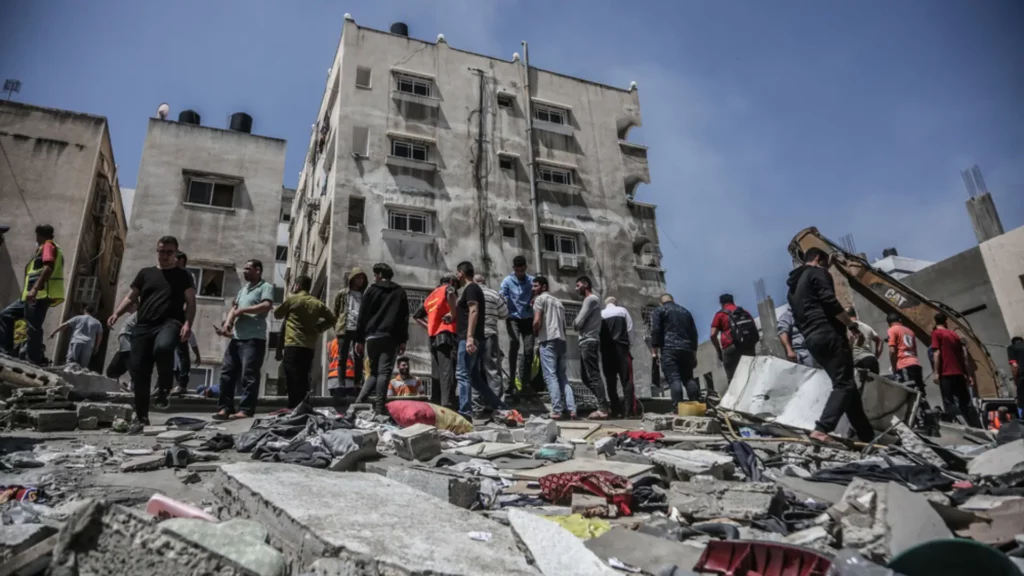The United Nations concluded that the fighting since Hamas killed over 1,000 Israelis on October 7 of last year has destroyed the remaining infrastructure and economy of Gaza in a report on the economic costs of the war published by the trade and development department.
Gaza’s economy is utterly devastated after year-long fighting between Israel and Hamas. The United Nations warned it would take over 350 years to recover and return to the level before its pre-conflict era.
The United Nations concluded that the fighting since Hamas killed over 1,000 Israelis on October 7 of last year has destroyed the remaining infrastructure and economy of Gaza in a report on the economic costs of the war published by the trade and development department.
Before the war, Israel and Egypt put a blockade on Gaza after Hamas took over power in 2007. Four previous wars and conflicts between Hamas and the Palestinian Authority, which is supported by the West Bank and backed by the West, negatively impacted the economy.
The report, presented to the UN General Assembly last month, claimed that apart from the minimum humanitarian health and food services provided during severe restrictions of water, fuel, and electricity as well as severe access restrictions, the economic activity in Gaza, which was already weak before the war, has completely stopped.
The current war has caused adverse effects on the region, as the road infrastructure and the entire community are destroyed. Before reconstruction could start, the mountains, which contained unexploded weapons and decomposing bodies, needed to be removed.
There was a reduction in the construction output by 96%, agriculture output by 93%, manufacturing by 92%, and the service sector by 76%. In the first quarter of 2024, unemployment reached 81.7%. UN predicted that this percentage rate would worsen or stay the same as long as military operations continued.
According to a report, the intense military operation in Gaza resulted in an unparalleled humanitarian, environmental, and social disaster, which led Gaza from de-development to destruction.
It might take decades to restore Gaza to its pre-crisis state. Once there is an agreement to ceasefire, it would take the gross domestic product of Gaza 350 years to return to its 2022 level.
Under the so-called Gaza Reconstruction Mechanism, the Norwegian Refugee Council organized an international coalition of aid providers called the Shelter Cluster. It estimated how long it would take to restore all the damaged homes. It concluded that it would take 40 years to rebuild every home under that setup.
According to the report, the restrictions imposed by Israel on the movement of people and goods in Gaza significantly impacted the economy between the period of 2007 and 2022. Due to the ongoing military activity for the past 12 months, it has increased its impact on the economy.
According to the UN, there was an enormous money loss due to the military operations and limitations.
An estimate published in a report says that if there were no restrictions in Gaza, the gross domestic product of Gaza would have reached an average of 77.6% more than the actual level by the end of 2023.
Before the war started, the Gazan economy was shrinking at an annual rate of about 3% in the first three quarters of 2023. Overall, it declined by 22.6% in 2023, with 90% of the decline in the fourth quarter of the year.
According to the report, by the end of July 2024, 45 out of 105 primary health institutions will be non-operational, 21 out of 36 hospitals will be closed, and 88% of educational buildings have sustained some damage. Over 59% of the water, sanitation, and hygiene infrastructure was severely damaged, affecting water and sanitation services, while over 62% of residential buildings were either destroyed or severely damaged.
According to Unctad, Gaza saw its worst economic downturn in the fourth quarter of 2023. Compared to the third quarter of 2023, GDP declined by 80.8%, and GDP per capita decreased by 81.4% within that same period.
